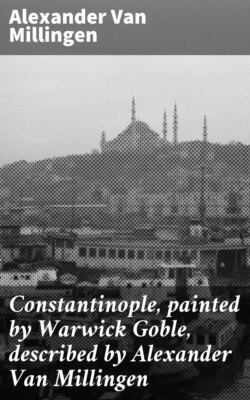Читать книгу Constantinople, painted by Warwick Goble, described by Alexander Van Millingen - Alexander Van Millingen - Страница 5
На сайте Литреса книга снята с продажи.
ОглавлениеA FLOWER-MARKET, SCUTARI
What the feelings of the “oldest inhabitant” of Byzantium were on that day it is not difficult to imagine. Any regret at the disappearance of ancient and familiar landmarks would be lost in pride for the honour which the old place had received, and in admiration of the magnificence with which it was invested. Moreover, many features of the past had only been transfigured, so that the new was not altogether strange. The Hippodrome, which had stood for more than 130 years an unfinished pile, was now completed; its seats were packed with spectators, and around its spina, chariots whirled like the wind. The Baths of Zeuxippus kept their place, but enlarged and beautified. The open space to the north of the Baths was converted into a square, surrounded by porticoes, and named Augustaion, after the title Augusta bestowed upon the Emperor’s mother. On the eastern side of the place stood the Senate-House, with a colonnade of six noble columns before the entrance. At the north-western corner of the square was the Milion, whence distances from New Rome were to be measured. To the north, the church dedicated to Irene proclaimed the new faith of the Empire, and told of the peace which had enfolded the Roman world when Constantine became sole Emperor. The ground now occupied by the Mosque of Sultan Achmed, to the east of the Hippodrome, was appropriated for the buildings which were to constitute the imperial palace. The fortifications along the west of the old town had been removed, but instead rose ramparts which could render greater service to mankind, and had a wider outlook upon the world. On the territory within the principal gateway of Byzantium, a forum had been constructed, named after Constantine, and there stood a porphyry column, surmounted by his statue watching over the city. The forum, elliptical in shape, was enclosed by a double tier of porticoes, with entrances on the east and the west through fine archways of marble. It was the business centre of the city. Proceeding westwards to the hill now occupied by the Turkish War Office, one came to buildings that recalled the Capitol of Rome; while on the hill now crowned by the Mosque of Sultan Mehemet rose the church dedicated to the Holy Apostles, in and around which the Emperors of Constantinople were to be laid to rest when, in the language of the Byzantine Court ceremonies, the Kings of kings summoned them to appear before Him. Aqueducts and cisterns provided an abundant supply of water for numerous public baths and fountains, as well as for private use. The principal streets were lined with porticoes affording shelter from sun and rain. The sewers ran deep underground. And the waters of a harbour, one of the greatest needs of the city, on its southern side gleamed in the bend of the shore of the Sea of Marmora, where the vegetable gardens of Vlanga Bostan now flourish. It was known, after the superintendent of the works, as the Harbour of Eleutherius.
Statues, many of them the work of the finest chisels of antiquity, had been collected from all parts of the Empire to make the new capital a museum of art, and to foster the love of the beautiful. Historical monuments also were there, to suggest the continuity between the past and the present, and to rouse the men of a new age to emulate the noble deeds of the old time before them. Of these monuments none was so inspiring as the Serpent Column brought from Delphi to the Hippodrome, upon whose lowest thirteen coils are graven the names of the heroic little States which hurled the Persians out of Greece. No monument stood more appropriately in a city whose supreme task was to resist the encroachments of barbarism upon the civilised world. Scattered over the city were palatial mansions, some erected at the Emperor’s order for personages whom he wished to attract to the new capital, others built by men of wealth and rank who had come of their own accord to bask in the sunshine of imperial favour. Persons belonging to other classes of society had also been attracted in crowds by openings for business, demand for labourers, exemption from certain taxes, and by the free distribution of bread, for which the cornfields of Egypt furnished 80,000 modii of wheat. After the pattern of Rome, the good order of the city was secured by the division of the city into fourteen wards or regions, of which twelve lay within the walls, and two were suburban. One of the latter, the 13th ward, was on the site of Galata; the other, the 14th ward, the famous suburb of Blachernæ, stood on the hill now occupied by the quarter of Egri Kapou. Both of these extra-mural suburbs were fortified. Each ward had a curator, who attended to the general interests of that portion of the city; a crier or messenger to give public notice to its inhabitants of matters which concerned them; five night watchmen; and a body of men (colligiati) representing the trade-guilds, and varying in number according to the size or importance of the ward, to render assistance in case of fire. After this survey of the new city, the most loyal son of the old town might come to the ancient Strategion—the ground devoted to military exercises (on the level tract beside the present Stamboul Railway Station)—and gladly bow to the decree inscribed on a column erected there, that Byzantium should henceforth be named New Rome.
THE GALATA BRIDGE
which spans the Golden Horn at the end near the Bosporus forms the principal link between Galata and Stamboul. It is presented here as seen through a window in a small café on one of the adjoining steamboat quays.
